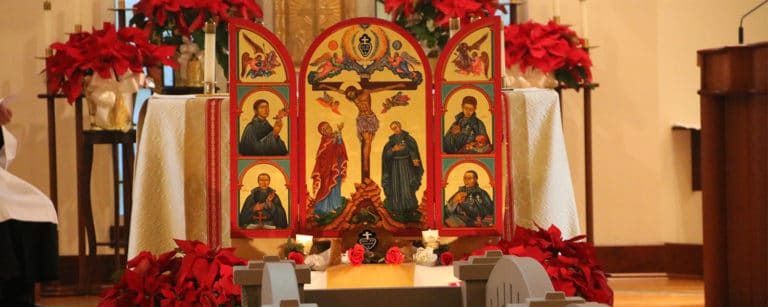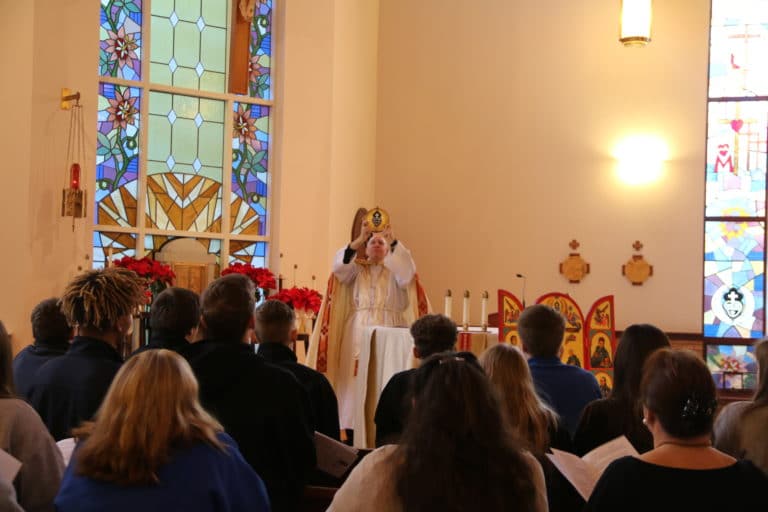
BY ELIZABETH WONG BARNSTEAD, THE WESTERN KENTUCKY CATHOLIC
An icon commissioned by the Passionist Fathers – along with a first-class relic of their founder, St. Paul of the Cross – has been traveling on pilgrimage around the world for the occasion of the Passionist congregation’s 300th anniversary.
On Jan. 30, 2020, the icon and relic were brought and made available for a Mass, prayer service and a few hours of veneration at St. Joseph Monastery in Whitesville, home to a community of cloistered Passionist nuns.
Mother John Mary Read, CP, the mother superior of St. Joseph Monastery, described it as “wonderful” to be able to host the icon and relic of their founder.
“We know an icon is not just a picture we look at, but is an image that allows us into the reality of the Paschal Mystery,” she said.
The icon features Jesus and aspects of his Passion including the crucifix, Calvary, and angels ministering to him. Also featured are St. Paul of the Cross and other Passionist saints such as St. Gabriel of the Sorrowful Virgin, Blessed Dominic of the Mother of God, St. Gemma Galgani and Blessed Isidore de Loor.
Three hundred years prior, in December 1720, St. Paul of the Cross had founded the Passionist congregation. In 1771, the first monastery of Passionist nuns was established, and Passionist nuns across the world will celebrate their 250th anniversary in 2021.

Also in 2021, the local Passionist nuns will celebrate the 75th anniversary of the establishment of their monastery in Owensboro, Ky. (This December, in 2020, they will celebrate the 25th anniversary of the monastery’s relocation from Owensboro to its present location in Whitesville.)
Fr. Louis Caporiccio, CPM, the chaplain of the monastery, presided at the Mass and prayer service.
If you want a true image of God, “look at his Passion,” said Fr. Caporiccio in his homily during the prayer service. He quoted the late priest and author, Fr. Thomas Dubay, in that celebrating something means affirming that “something is good.”
Fr. Caporiccio said everyone gathered in the chapel at St. Joseph Monastery were indeed “affirming that this foundation (of the Passionist congregation) is a very good thing!”
He said that to much of society, it seems odd to celebrate something so tragic – the death of an innocent man more than 2,000 years ago.
Looking at a crucifix, “all they see is a man who is humiliated, a man who is suffering, a man who is fastened to an ancient instrument of torture,” said Fr. Caporiccio.
And yet, “the Passion is a necessary condition to get to Heaven,” said Fr. Caporiccio, calling the Passion “a manifestation of God’s great love for the world – for you and for me.”
Several laypeople visitors attended the celebration that morning, as well as faculty, staff and the entire student body of Trinity High School in Whitesville.
Emily Hernandez, principal at Trinity, said she was grateful to the Passionists for extending an invitation for the high school to attend the prayer service. The day also coincided with annual Catholic Schools Week, which took place this year from Jan. 26- Feb. 1.
“Facilitating discipleship is what we do at Trinity High School, and this was a wonderful opportunity for our student body as we joined with these sisters in this powerful celebration,” said Hernandez. “We were so thankful our entire student body was able to celebrate such an event during Catholic Schools Week.”
Christopher Jungers, whose day job is serving as the director of East Coast donor relations for the Passionists of Holy Cross Province, had traveled with fellow volunteer Bob Rizzi of Baltimore to bring the icon and relic to this region.
Rizzi, who said he had always wanted to do a pilgrimage, considered the opportunity “a blessing in my life to be able to be a part of this.”
Jungers said he has found, as he has traveled across the United States, that their pilgrimage journey “touches people deeply and it goes so much to the heart for our Catholic faith.”
He said that for Catholics, “tangible” items like the relic and icon are “so comforting and grace-filled.”
“I feel as if I’m bringing to people a touchable, real sense of St. Paul of the Cross and the Passionists,” he said.
Click here for a photo gallery of the January 30 prayer service.
The Catholic Church and relics
BY EDWARD WILSON, SPECIAL TO THE WESTERN KENTUCKY CATHOLIC
There are three classes* of relics:
First-class: Remains from the body of a saint (e.g., bone fragment) as well as items directly associated with the events of Christ’s life or Passion (e.g., a piece of the True Cross).
Second-class: An item used or owned by a saint (e.g., a possession or fragment of clothing).
Third-class: An item (e.g., a piece of cloth) that has been touched to a first- or second-class relic. Often, a third-class relic is affixed to a prayer card or medal associated with a particular saint.
Relic veneration has a long and unbroken history in the Catholic Church. Perhaps the earliest recorded account occurred around 156 A.D., when the remains of St. Polycarp were gathered by his followers and placed in a designated space to be adored yearly on the date of his martyrdom.
Many believe that veneration of relics is no longer an accepted practice of the Church, following Vatican II. This, however, is not the case. The sacred status of relics has been affirmed numerous times, including at the Council of Trent (1545-1563), the Second Vatican Council (1962-1968), and in Pope St. John Paul II’s authorized 1983 Code of Canon Law (cf. canons 1281-89).
Scripture also supports the practice of veneration; Matthew 9:20-22, 2 Kings 13:20-21, Acts 19:11-12, and several other passages, illustrate the significance of relics. Though the practice may seem outdated to many, particularly in the West, relics continue to be a treasured part of Catholic practice. In 2019, Pope Francis even made headlines for gifting relics of St. Peter to Patriarch Bartholomew, the Orthodox Archbishop of Constantinople, revealing the sacred place that relics still occupy in the Catholic faith.
Tradition, canon law, and Scripture all support this practice that allows Catholics to both give honor to and attain a physical closeness with the Communion of Saints.
*Definitions courtesy of St. Anthony Chapel, Pittsburgh, Penn.
Edward Wilson is the director of the Diocese of Owensboro’s archives and the archives of the Ursuline Sisters of Mount Saint Joseph. To learn more, visit owensborodiocese.org/archives.
Originally printed in the March 2020 issue of The Western Kentucky Catholic.
Copyright © 2020 Diocese of Owensboro/The Western Kentucky Catholic
